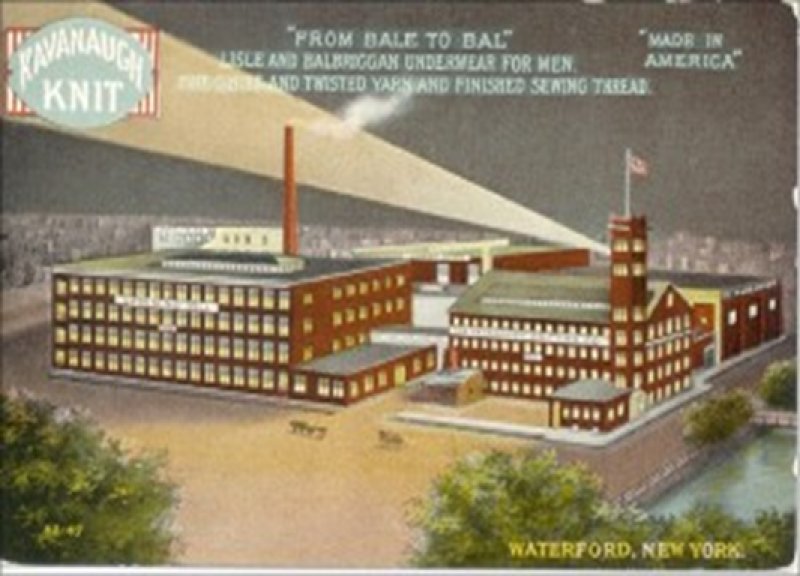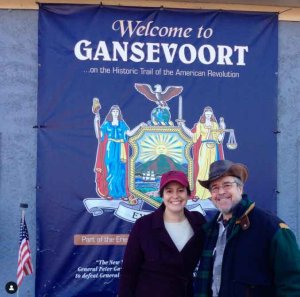The Town of Waterford’s population in 1910 was said to be 6,128. Of that number, approximately 1,700 worked in the twelve knitting mills making underwear! There were four other knitting mill operations that did not produce underwear; they employed 220. One-third of the overall population worked in the industry. Ruling out minors, the percentage would be even higher. By 1912 and continuing until the 1950s, underwear was Waterford’s largest export item.
Two of the Waterford manufacturers had pressing questions for the underwear-buying public.
Have you been bothered recently by dangerous underwear fads?
Do You need to purchase underwear in a larger size because it shrinks?
The Kavanaugh Knitting Mill, owned by the Kavanaugh family, was the largest factory, with 600 employees. Their business was built on the following belief.
Men who demand cool, comfortable garments and who appreciate good health avoid dangerous underwear fads usually wear the famous Kavanaugh Balbriggan. The comfortable underwear. Just loose enough to avoid the pinch, just light and soft enough for cool comfort, just weight enough to protect against sudden cool breezes.
This advertisement also featured caricature images of the Rough Riders. Charles Kavanaugh was a personal friend of Teddy Roosevelt. Kavanaugh provided all the underwear for the Rough Riders during the Spanish-American War
John Wheeler Ford, in 1891, the same year as the Kavanaugh mill, opened Ford’s Mill, or Ford’s Manufacturing. It was later purchased by the Robert Reis Company. Their main products were tee shirts and men’s and ladies’ undergarments. Their claim was as follows.
Reis’ Union Suits, we’ll put you wise; you needn’t buy them oversize. The size mark on Reis’ Lavender Label means precisely what it says. All athletic underwear shrinks when first laundered. Instead of pretending that it doesn’t. Reis, frankly, allows for shrinkage. So you needn’t buy a 42 when your size is 38 or a 38 when your size is 34. It’s sized right in the first place. Reis, you see, doesn’t skimp on material. Yet, for all the roominess of a Reis, they are tailored to fit. It doesn’t flop around you like a sail or wrap you up like a bug. They fit, and of course, they don’t chafe. They are made for a man, not a wax figure.
Reis’ Mill lasted the longest - in business until 1979. Their main office was in the Empire State Building. The bulk of their manufacturing was conducted at Ford’s Mill in Waterford. During World Wars I and II, they held contracts to supply underwear to the United States Army. The employment there was listed as 300.
During the first half of the 20th century, the Harmony Mills in Cohoes and the Ford and Kavanaugh Mills in Waterford all had military contracts that impacted their ability to produce, distribute, and sell civilian supplies. The others were quick to fill the void. In the second half of the 20th century, with the wars over, the Ford Mill, now Reis, but still known as Ford’s Mill, returned to normal operations. By the mid-1950s, they were the only one left. All the others had gone out of business. Of the twelve mills that were listed that produced underwear, several had majestic brick buildings. They are now all gone, with the exception of the Laughlin Textile Mill, which is vacant. It was the headquarters for Ursula of Switzerland. Ursula passed away recently. That marked the closing of the textile industry in Waterford.
How was Waterford able to become one of the Mohawk Valley’s major producers of underwear?
Waterpower was the top priority in the development and location of textile mills which was abundant in the Waterford and Cohoes area. The Mohawk River, and in Waterford the King’s Canal, provided plenty of rushing water, the humidity was sufficient for spinning, access to seaports was convenient with the Erie and Champlain Canals, and there was an abundant labor supply. For these reasons, the textile industry took root across the northeast, along the Mohawk River valley, and especially at the terminal point of the canals in Waterford and Cohoes.
In 1855, Clark Tompkins, from Troy, NY, patented the first fully mechanized knitting machine. The upright rotary knitting machine relied on mechanical advances not available until the 1840s. In many ways, this invention foretold the industrial future for the Hudson and Mohawk River Valleys. By 1890, Mohawk Valley had become the number one knit-goods manufacturing center in the country.
New York knit-goods manufacturers primarily produced underwear.Two-thirds of all underwear produced in the United States in the late 19th century was made in New York, and of that, a large percentage came from the Mohawk Valley. In 1909, The Knit Underwear Industry reported that New York State produced 33.5% of all knit goods in the United States. With the opening of the King’s Canal in 1830, Waterford successfully harnessed the power available from the Mohawk River. The King’s Canal area became heavily industrialized, with more than half of the underwear manufacturing concerns listed located.
Kavanaugh made mention of Dangerous Underwear Fads. The Utica Brand underwear company asked, tired of underwear fads? Many hours were spent searching newspapers for those fads. Following are some of the underwear fads that appeared between 1890 and 1940.
I found evidence of the underwear that doesn’t have to be ironed. Material fads of fine rayon mesh, nalmook, and crepe. A no underwear fad. A black underwear fad during the Depression to cut down on washing. A pretty underwear fad. Silk underwear. Colored underwear. Dr. Diemel underwear fad. Velvet underwear fad. In 1929, a lightweight underwear fad was to blame for hospital admissions. None seemed particularly dangerous unless you were in Illinois, where in 1929 lightweight underwear apparently caused hospitalizations, and the wearing of silk underwear was successful grounds for divorce.
Russ VanDervoort is the Waterford Town Historian, leader of the Waterford Canal and Towpath Society and a Trustee of the Saratoga County History Center. He can be reached at This email address is being protected from spambots. You need JavaScript enabled to view it.





































